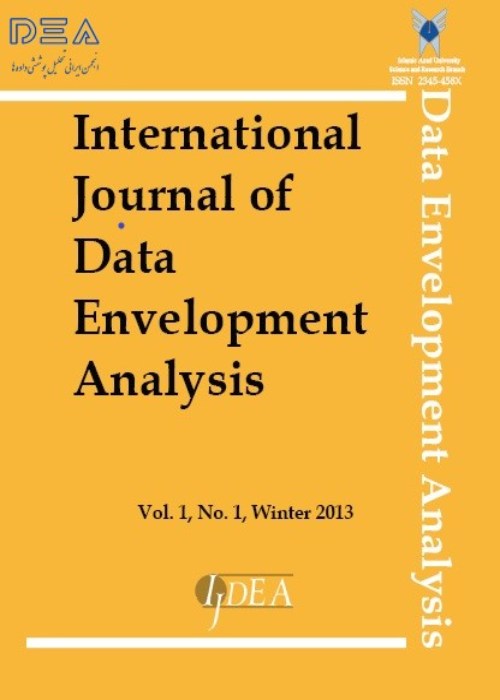فهرست مطالب
International Journal of Data Envelopment Analysis
Volume:1 Issue: 2, Apr 2013
- تاریخ انتشار: 1392/01/12
- تعداد عناوین: 6
-
Pages 55-59
In this paper imprecise target models has been proposed to investigate the relation between imprecise data envelopment analysis (IDEA) and mini-max reference point formulations. Through these models, the decision makers' preferences are involved in interactive trade-off analysis procedures in multiple objective linear programming with imprecise data. In addition, the gradient projection type method can be suggested to determine a normal vector at a given efficient solution on the efficient frontier and to establish an interactive procedure for searching for the most preferred solution (MPS) that maximizes the decision maker implicit utility function
Keywords: Data Envelopment Analysis, gradient projection method, multiple objective linear programming, Imprecise data -
Pages 61-73
This paper proposes a suitable benchmark for inefficient commercial bank branches by using Data Envelopment Analysis (DEA). In order to render an inefficient bank branch efficient, it is necessary to decrease inputs and increase outputs. As there are priorities for decreasing some certain inputs and increasing some certain outputs over other inputs and outputs, respectively, it is necessary to consider and incorporate the managers’ view regarding the priorities in the models which are applied. So, in this paper, using the enhanced Russell model for an inefficient bank branch, we propose the decrease in inputs and the increase in outputs, taking the managers’ priorities into account. Finally, in a numerical example, we apply the proposed procedure to the authentic information from 30 commercial bank branches, to show the application of the procedure.
Keywords: Data Envelopment Analysis, Benchmark, Linear Programming -
Pages 75-83In this paper, presenting two simple methods for ranking of efficient DMUs in DEA models that included to add one virtual DMU as ideal DMU and is using the additive model. Note that, we use an ideal point just for comparing efficient DMUs with. Although these methods are simple, they have ability for ranking all efficient DMUs, extreme points and the others, also they are capable of ranking the whole DMUs at special cases that previous methods could not ranked them or they can be ranked with hard computingKeywords: Data Envelopment Analysis, Ranking, Ideal point, Efficiency, Additive model, Norm
-
Pages 85-96
The present study is an attempt towards remodeling cost, revenue and profit relationship within the network process. The previous models of Data Envelopment Analysis (DEA) have been too general in their scope and focused on the input and the output within a black box system, therefore they have not been able to measure various phases simultaneously within a network system. By using these models internal linking activities are neglected. A slacks-based network DEA model is dealt with intermediate products (Tone,Tsutsui). In this development, each input and output can use situations where unit price and unit cost information are available. In this paper we introduce models of cost, revenue and profit efficiency in network DEA. These models are illustrated by numerical examples and finally results of Constant Returns to Scale (CRS) are obtained. The findings could be used in minimizing the costs and maximizing the benefits in various organizations, public services, factories, and public and private sector companies.
Keywords: Data envelopment analysis (DEA), New Network Cost Efficiency (NNCE), New Network Revenue Efficiency (NNRE), New Network Profit Efficiency (NNPE) -
Pages 97-106
Because of the piecewise linear nature of the data envelopment analysis (DEA) frontier, the optimal multipliers of the DEA models may not be unique. Choosing weights from alternative optimal solutions of dual multiplier models is one of the most frequently studied subjects in the context of DEA. In this paper, the authors have been inspired by the idea of Cooper et al. (2011) to propose a linear programming problem in which a specific decision making unit chooses the optimal solution of a linear program as the profile of weights for use in the cross-efficiency calculation. The approach proposed in this paper to determine input/output weights, prohibit the large differences in weights in cross efficiency evaluation. A real case on Chinese cities and special economic zones is given to illustrate the applicability of the proposed approach.
Keywords: Data Envelopment Analysis, Cross-efficiency, input, output weights -
Pages 107-118
In this article, Non radial method of dynamic DEA with the parallel network structure is presented and is used for calculation of relative efficiency measures when inputs and outputs do not change equally. In this model, DMU divisions under evaluation have been put together in parallel. But its dynamic structure is assumed in series. Since in real applications there are undesirable inputs and outputs in the proposed model, the assumption of the existence of the intermediate products have been considered. After obtaining period–divisional efficiencies, by considering its weighted arithmetic mean, models are presented for the evaluation of period, divisional and overall efficiency for decision making unit
Keywords: dynamic data envelopment analysis – parallel network – overall efficiency – links, variable carry-overs


